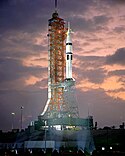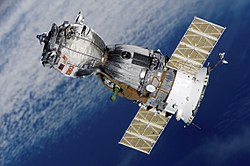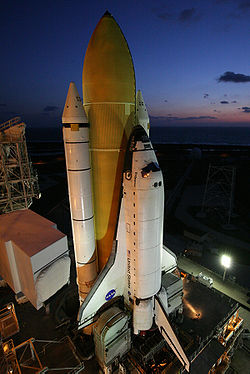Portál:Kosmonautika/Archiv obrázků
Toto je archiv obrázků, které již byly zveřejněné na portálu Kosmonautika.
ISS after STS-120 in November 2007.jpg

Mezinárodní vesmírná stanice (International Space Station - ISS) je v současné době jediná trvale obydlená vesmírná stanice. První díl stanice, modul Zarja, byl vynesen na oběžnou dráhu 20. listopadu 1998. Od 2. listopadu 2000, kdy na stanici vstoupila první stálá posádka, je trvale obydlena alespoň dvoučlennou posádkou, která se každých 6 měsíců obměňuje. Stanice je umístěna na nízké oběžné dráze Země ve výšce okolo 360 km s periodou oběhu 92 minut.
Aldrin Apollo 11.jpg

Buzz Aldrin - druhý člověk, který vstoupil na povrch Měsíce. V roce 1969 se zúčastnil jako pilot lunárního modulu mise Apollo 11 (spolu s velitelem Neilem Armstrongem a s pilotem velitelského modulu Michaelem Collinsem).
STS-123 Landing2.jpg
Raketoplán Endeavour při nočním přistání 27. března 2008 v 0:40:41 UTC na Kennedyho vesmírném středisku na Floridě po ukončení úspěšné mise STS-123 k Mezinárodní vesmírné stanici, kam dopravil první část japonské laboratoře Kibō a kanadský manipulátor Dextre.
Soyuz TMA-7 spacecraft2edit1.jpg

Kosmická loď Sojuz-TMA je zdokonalená verze ruského pilotovaného dopravního prostředku do vesmíru. Tato inovovaná varianta se používá od roku 2002 k dopravě kosmonautů na Mezinárodní vesmírnou stanici (ISS) a zároveň slouží jako záchranný člun pro posádku ISS. Vzhledem k tomu, že někteří američtí astronauti vyššího vzrůstu by nemohli předchozí verze lodí Sojuz-TM využívat jako záchranného člunu, byla vytvořena varianta Sojuz-TMA (транспортный модифицтрованный антропометрический) s upravenými křesly; kromě toho byla zdokonalena elektronika, výpočetní technika a motory měkkého přistání.
Apollo 1 fire.jpg

Pohled do zničené kabiny kosmické lodě Apollo 1 po požáru, který vznikl 27. ledna 1967 při cvičné simulaci odpočítávání. V kabině s atmosférou z čistého kyslíku došlo k elektrickému zkratu, zahynula celá posádka – velitel letu Virgil Ivan „Gus“ Grissom, Edward Higgins White a Roger Bruce Chaffee.
Soyuz rocket engines.jpg
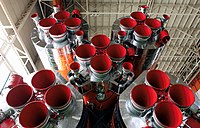
Záběr na raketové motory Ruské kosmické lodi Sojuz umístěné v hangáru kosmodromu Bajkonur.
Kibo PM interior.jpg
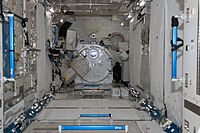
Pohled do interiéru přetlakového modulu japonské laboratoře Kibō, který k Mezinárodní vesmírné stanici (ISS) dopravil raketoplán Discovery při misi STS-124 v červnu 2008. Modul má válcovitý tvar, je 11,2 m dlouhý a má průměr 4,4 m. Laboratoř, ke které ještě patří experimentální logistický modul ELM-PS (dopraven k ISS při misi STS-123) a venkovní plošina, se stane největším výzkumným pracovištěm na stanici.
Phoenix Scoop.jpg

Phoenix je robotická sonda agentury NASA, která úspěšně přistála 25. května 2008 ve 23:38 UTC na povrchu planety Mars v polární oblasti Vastitas Borealis. Na snímku panoramatické stereoskopické kamery s vysokým rozlišením SSI (Surface Stereoscopic Imager) je vidět část solárního panelu sondy a robotické rameno při odběru vzorků.
Buzz Aldrin's bootprint on the Moon, AS11-40-5877 (21472308758).jpg

Otisk stopy pilota lunárního modulu Apolla 11 Buzze Aldrina v měsíčním prachu. Aldrin vyfotografoval tento otisk během měsíční vycházky 20. července 1969 jako součást zkoumání mechanických vlastností měsíčního povrchu. Snímek se stal symbolem lidské odvahy při zkoumání vesmíru.
STS-79 rollout.jpg

Pohled z výšky na raketoplán Atlantis, umístěný na mobilní platformě MLP a chystající se na misi STS-79. Pomocí přepravního transportéru (Crawler-Transporter) je raketoplán přepraven z montážní budovy VAB (Vehicle Assembly Building) na odpalovací rampu 39-A.
NASA-Apollo8-Dec24-Earthrise.jpg
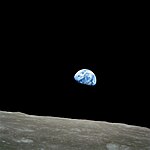
Fotografie Země z oběžné dráhy Měsíce byla pořízena členem posádky Apolla 8 Williamem Andersem 24. prosince 1968, kdy se Američanům podařilo jako prvním obletět Měsíc s lidskou posádkou.
Soyuz TMA-5 launch.jpg

Start mise Sojuz TMA-5, který se uskutečnil na kosmodromu Bajkonur 14. října 2004. Kosmická loď Sojuz s posádkou Saližan Šaripov, Leroy Chiao a Jurij Šargin mířila k Mezinárodní vesmírné stanici.
S-IC engines and Von Braun.jpg

Konstruktér Wernher von Braun u motorů F-1 nosné rakety Saturn V, kterou NASA použila v rámci programu Apollo pro dopravu člověka na Měsíc.
Apollo13-load on deck crop1.jpg

Velitelský modul Apolla 13 při naloďování na palubu lodi USS Iwo Jima. Apollo 13 přistálo v jižní části Tichého oceánu 17. dubna 1970 po neúspěšném letu na Měsíc.
STSCPanel.jpg

Kokpit raketoplánu Atlantis byl poprvé v historii prosklený během letu STS-101.
NASA Apollo 17 Lunar Roving Vehicle.jpg

Astronaut Eugene A. Cernan vyzkoušel na Měsíci při misi Apollo 17 terénní průzkumné vozidlo Lunar Rover - LRV (Lunar Roving Vehicle).
Armadillo Aerospace Pixel Hover.jpg
Raketa Pixel společnosti Armadillo Aerospace při testu vznášení. Společnost se v roce 2006 s tímto zařízením zúčastnila soutěže X Prize Cup.
X-33 larc big.jpg

X-33 byl letový model (v polovičním měřítku - délka 20,3 m, rozpětí 20,6 m) vícenásobně použitelného nosného prostředku RLV (Reusable Launch Vehicle) VentureStar. Model postavila firma Lockheed Martin v roce 1997. Projekt VentureStar měl nahradit raketoplány Space Shuttle po ukončení jejich činnosti, ale po technických problémech byl projekt v roce 2001 definitivně ukončen.
Endeavour PadB.jpg

Raketoplán Endeavour čekající na startovací rampě 39B na start mise STS-126 k Mezinárodní vesmírné stanici. Raketoplán úspěšně odstartoval 15. listopadu 2008 v 00:55:39 UTC a následující den se spojil se stanicí.
Atlantis Docked to Mir.jpg
Raketoplán Atlantis při misi STS-71 zakotvený u sovětské vesmírné stanice Mir. Snímek pořídili 4. července 1995 kosmonauti Anatolij Solovjov a Nikolaj Budarin při obletu stanice v kosmické lodi Sojuz.
Space suit.jpg

Americký kosmický skafandr Extravehicular Mobility Unit (EMU), používaný při výstupech do otevřeného kosmického prostoru. Skafandr používají astronauti při letech raketoplánů a na Mezinárodní vesmírné stanici.
125750main in-flight-lg.jpg

Raketoplán Discovery přepravovaný na modifikovaném letounu Boeing 747 Shuttle Carrier Aircraft z Edwardsovy letecké základny v Kalifornii do Kennedyho vesmírného střediska na Floridě 19. srpna 2005. Přelet z Kalifornie na Floridu trvá dva dny s několika mezipřistáními na doplnění paliva.
LR91-AJ-11 rocket engine - Thrust chamber.jpg

Pohled do trysky raketového motoru LR-91-11. Jedná se o raketový motor na kapalné pohonné látky, používaný na druhém stupni raket Titan.
Shuttle mate demate facility.jpg

Raketoplán Atlantis je nakládán na Edwardsově letecké základně na horní část letounu Boeing 747 Shuttle Carrier Aircraft po letu STS-44 v roce 1991.
Apollo 11 Lunar Module Eagle in landing configuration in lunar orbit from the Command and Service Module Columbia.jpg

Lunární přistávací modul Eagle mise Apollo 11 s Neilem Armstrongem a Buzzem Aldrinem na palubě. Snímek by pořízen 20. července 1969 na oběžné dráze Měsíce z velitelského modulu Columbia.
Iss016e034191.jpg

Evropská nákladní zásobovací loď ATV-1 Jules Verne přibližující se 31. března 2008 k Mezinárodní vesmírné stanici (ISS).
STS039-367-006 - STS-39 Critical Ionization Velocity (CIV) gas release from OV-103 payload bay.jpg

Experiment během "vojenské" mise raketoplánu Discovery STS-39.
STS-124 Karen window.jpg
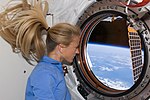
Astronautka Karen Nybergová, specialistka z mise STS-124 v roce 2008, hledí oknem z nově instalované laboratoře Kibō na ISS.
Michael Gernhardt in space during STS-69 in 1995.jpg

Americký astronaut Michael Gernhardt při výstupu do vesmíru během mise STS-69 v roce 1995, připevněný na konci robotické paže raketoplánu Endeavour.
Apollo 11 launch.jpg

Kosmická loď Apollo 11 odstartovala 16. července 1969 na misi na Měsíc, při níž poprvé vstoupil člověk na měsíční povrch. Na palubě Apolla 11 byli američtí astronauti Neil Armstrong, Michael Collins a Buzz Aldrin. Nosná raketa Saturn V na snímku právě překonává rychlost zvuku.
Goddard and Rocket.jpg
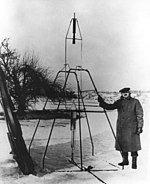
Dr. Robert Hutchings Goddard při testu raketového motoru na kapalné pohonné látky (kapalný kyslík a benzín) 16. března 1926 v Auburnu, Massachusetts. Robert H. Goddard položil praktické základy vývoje raket a spolu s Konstantinem Ciolkovským a Hermannem Oberthem se stal jedním ze zakladatelů raketové techniky.
Ares-V launch.jpg

Ilustrace startu rakety Ares V. Ares V je těžká vyvíjená raketa NASA pro lety na Měsíc a dál v rámci programu Constellation. Má dva stupně a je navržena pro vynesení lunárního modulu Altair na nízkou oběžnou dráhu a pak s lodí Orion k Měsíci.
NASA Mars Rover.jpg
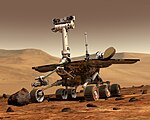
Mars Exploration Rover (zkr. MER) je název kosmické mise dvou identických sond (MER-A a MER-B) americké agentury NASA nesoucí mobilní robotická vozítka pro průzkum planety Mars. Vozítka byla pojmenována Spirit a Opportunity. Spirit byl vypuštěn 10. června 2003 a na Marsu přistál 4. ledna 2004. Opportunity odstartovala krátce nato 7. července 2003 a přistála 25. ledna 2004. Na obrázku je rover MER na Marsu v představě umělce.
ASTP Saturn IB.jpg

Zkušební odpočítávání (Countdown Demonstration Test) dvoustupňové rakety Saturn IB před startem kosmické lodi Apollo 18. Ta se později spojila na oběžné dráze se sovětskou lodí Sojuz 19 v rámci společného letu Sojuz-Apollo.
207166main iss016e018575 high.jpg

Posádka Expedice 16 při oslavách vánoc 25. prosince 2007 na palubě Mezinárodní vesmírné stanice. Na snímku zleva je ruský kosmonaut palubní inženýr Jurij Malenčenko, velitelka stanice Peggy Whitsonová a palubní inženýr Daniel Tani (oba NASA).
Soyuz TMA-7 approach.jpg

Kosmická loď Sojuz TMA-7 se 3. října 2005 přiblížila k Mezinárodní vesmírné stanici (ISS) a úspěšně se s ní spojila. Na palubě Sojuzu přiletěli členové posádky Expedice 12 Valerij Tokarev a William McArthur a s nimi i vesmírný turista Gregory Olsen.
HTV after grapple.jpg
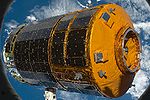
Nákladní bezpilotní kosmická loď H-II Transfer Vehicle (HTV) japonské kosmické agentury JAXA dopravila 17. září 2009 na Mezinárodní vesmírnou stanici (ISS) 4,5 tuny zásob, vybavení a náhradních dílů.
Aerial View of Ares I-X at Launch Pad 39B.jpg

Startovací rampa LC-39B na Kennedyho vesmírném středisku na mysu Canaveral, na níž se k letu připravovala raketa Ares I-X. Úspěšný start proběhl 28. října 2009.
Image-Pegasus XL IBEX in clean room 02.jpg

Montáž sondy IBEX (Interstellar Boundary Explorer) do úložného prostoru nosné rakety Pegasus XL /Star 27 na letecké základně Vandenberg v Kalifornii. Start sondy se uskutečnil 19. října 2008.
Bumper8 launch-GPN-2000-000613.jpg

První start rakety z mysu Canaveral proběhl 24. července 1950, kdy odtud odstartovala dvoustupňová raketa Bumper 8. Její první stupeň tvořila balistická střela V-2 a druhý sondážní raketa WAC Corporal.
Progress M-52.jpg
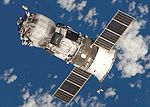
Nákladní kosmická loď Progress M-52 (ISS-17P) vyfotografovaná posádkou Expedice 11 po odpojení od Mezinárodní vesmírné stanice (ISS) 15. června 2005. Progress, který na ISS dopravil několik tun zásob, byl naplněn odpadem a nasměrován do hustých vrstev atmosféry, aby zde zanikl.
Delta 7320-10C at sunrise with SWIFT on board.JPG

Nosná raketa Delta II s kosmickou observatoří Swift očekávající start na rampě 17-A základny Cape Canaveral Air Force Station na mysu Canaveral (Florida). Úspěšný start proběhl 20. listopadu 2004 v 17:16 UTC.
Gemini_6_Views_Gemini_7.jpg

Kosmická loď Gemini 6A vyfotografovaná 15. prosince 1965 posádkou Gemini 7 na oběžné dráze kolem Země ve výšce 257 km. Obě lodi se k sobě přiblížily až na vzdálenost 0,3 m, k fyzickému spojení však nedošlo, protože Gemini 7 nebyla vybavena potřebným spojovacím zařízením.
China Xichang Satellite Center - Tianlian I-01 Launch.jpg
Čínská třístupňová raketa Dlouhý pochod 3C očekávající 26. dubna 2008 start na kosmodromu Si-čchang. Na oběžnou dráhu vynesla telekomunikační, sledovací a retranslační družici Tianlian I-01.
Sergei Konstantinovich Krikalev.jpg

Sergej Konstantinovič Krikaljov je bývalý sovětský a ruský kosmonaut ruské národnosti. V letech 1988–2005 absolvoval šest kosmických letů o celkové délce 803 dní a osm výstupů do vesmíru. Od roku 2005 drží rekord v celkové délce pobytu v kosmu. Od března 2009 je prvním civilním náčelníkem Střediska přípravy kosmonautů J. A. Gagarina v Hvězdném městečku.
Thorad Agena with SERT-2.jpg

Raketa Thorad-Agena připravená ke startu do vesmíru na kosmodromu Western Test Range v Kalifornii. Do kosmu vynesla sondu SERT-2 (Space Electric Rocket Test-2) určenou pro testování elektrického iontového pohonného systému. Start proběhl 4. února 1970.
STS-125 EVA4 Mass.jpg

Americký astronaut italského původu Michael Massimino při čtvrtém výstupu do vesmíru z raketoplánu Atlantis 17. května 2009. Výstup se uskutečnil v rámci servisní mise STS-125 k Hubbleovu vesmírnému dalekohledu.
Expedition 23 Landing.jpg
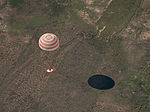
Kosmická loď Sojuz TMA-17 při přistání poblíž Džezkazganu v Kazachstánu 2. června 2010. Na Zemi se v lodi po půlročním pobytu na Mezinárodní vesmírné stanici (ISS) vrátili členové Expedice 23 Oleg Kotov, Timothy Creamer a Sóiči Noguči.
STS-78 Launch.jpg

Start raketoplánu Columbia na misi STS-78 proběhl 20. června 1996
STS-129 and Ares I-X.jpg

Testovací raketa Ares I-X startuje 28. října 2009 z rampy LC-39B na Kennedyho vesmírném středisku. Na sousední rampě LC-39A čeká raketoplán Atlantis na start mise STS-129
Progress M-62.jpg

Nákladní vesmírná loď Progress M-62 připojená 26. prosince 2007 k modulu Pirs Mezinárodní vesmírné stanice (ISS)
As17-134-20382.jpg

Pilot lunárního modulu astronaut Harrison Schmitt na povrchu Měsíce 13. prosince 1972 při misi Apollo 17. Tato mise byla zatím posledním letem člověka na Měsíc.
Kepler mission Delta II liftoff.jpg

Nosná raketa Delta II odstartovala 7. března 2009 v 03:49 UTC ze startovací rampy LC-17B z kosmodromu na Cape Canaveral Air Force Station. Do vesmíru vynesla kosmický teleskop Kepler, který na heliocentrické dráze vyhledává vzdálené exoplanety podobné Zemi.
Antonín Vítek (2).jpg

Mgr. Antonín Vítek, CSc., pracovník Akademie věd České republiky a přední popularizátor a znalec v oboru kosmonautiky, zemřel 28. února 2012 ve věku 72 let. Za dlouholetou a cíleně vedenou činnost v popularizaci vědeckých poznatků a za vedení internetové kosmonautické encyklopedie SPACE 40 získal řadu ocenění, byla po něm pojmenována planetka (30253) Vítek.
Curiosity Mars Science Laboratory Rover.jpg

Americké vozítko Mars Science Laboratory (MSL) při testech mobility v Kennedyho vesmírném středisku v červnu 2011. V současné době se rover nachází na přeletové trajektorii k planetě Mars, kde bude alespoň jeden marťanský rok zkoumat povrch a hledat stopy mikrobiálního života.
Dragon capsule.jpg

Kresba kosmické lodi Dragon na oběžné dráze Země. Dragon vyvinula a postavila americká společnost SpaceX s finanční podporou NASA, vynášena je raketou Falcon 9, též výrobkem SpaceX. První zkušební let lodi proběhl 8. prosince 2010, během druhého letu (od 22. května 2012) loď přivezla přes půl tuny nákladu na Mezinárodní vesmírnou stanici.
Média použitá na této stránce
Autor: Armadillo Aerospace/Matthew C. Ross, Licence: CC BY 3.0 us
Captive test flight of Armadillo Aerospace's Pixel rocket before the 2006 X-Prize Cup.
- Stručný popis: Astronaut Buzz Aldrin na Měsíci
- Podrobný popis: Pilot lunárního modulu Buzz Aldrin stojí na povrchu Měsíce vedle nohy přistávacího modulu "Eagle" (Orel). V hledí jeho přilby se odráží Neil Armstrong. Fotografie byla pořízena při výstupu během výpravy Apollo 11. Pořídil ji velitel výpravy, astronaut Neil A. Armstrong pomocí speciálně upraveného 70mm fotoaparátu Haselblad. Třetí člen výpravy zůstával během přistání jako pilot ve velitelském modulu na oběžné dráze kolem Měsíce.
- Úpravy: Černý pruh, tvořící horní okraj fotografie, byl přidán dodatečně, aby fotografie měla vyváženější kompozici. O stejnou šířku je seříznuta krajina před postavou, aby byl zachován čtvercový formát snímku. Scan z původního filmu je přístupný na stránkách NASA. Na snímcích chybí anténa na vršku "batohu", protože se nevešla do původního záběru.
Dawn breaks behind the ASTP Saturn IB launch vehicle during the Countdown Demonstration Test. The Mobile Service Structure was moved away from the vehicle for the test, which is a step-by-step dress rehearsal for the launch culminating in a simulated T-zero and launch. During the test, the stages of the Saturn IB rocket are fueled as they will be on launch day, July 15. Following the simulated liftoff, the fuels will be offloaded and the terminal portion of the count will be repeated tomorrow with the prime crewmen Thomas Stafford, Vance Brand and Donald Slayton aboard the spacecraft.
Astronaut Karen Nyberg, STS-124 mission specialist, looks through a window in the newly installed Kibo laboratory of the International Space Station while Space Shuttle Discovery is docked with the station.
Posádka Expedice 16 pózující pro vánoční foto v servisním modulu Zvezda na Mezinárodní vesmírné stanici. Na snímku zleva je kosmonaut Jurij Malenčenko, zastupující Ruskou federální kosmickou agenturu, astronauti NASA velitelka Peggy Whitsonová a letový inženýr Daniel Tani.
Soyuz programı kapsamında 1 Ekim 2005'te fırlatılan ve 8 Nisan 2006'da görevini tamamlayan Soyuz TMA-7.
Vandenberg Air Force Base, Calif. – Inside a protected clean room tent on Vandenberg Air Force Base in California, workers install the fairing around NASA’s Interstellar Boundary Explorer, or IBEX, spacecraft. The fairing is a molded structure that fits flush with the outside surface of the rocket and forms an aerodynamically smooth nose cone, protecting the spacecraft during launch and ascent. The IBEX satellite will make the first map of the boundary between the Solar System and interstellar space. IBEX is targeted for launch from the Kwajalein Atoll, a part of the Marshall Islands in the Pacific Ocean, on Oct. 19. IBEX will be launched aboard a Pegasus rocket dropped from under the wing of an L-1011 aircraft flying over the Pacific Ocean. The Pegasus will carry the spacecraft approximately 130 miles above Earth and place it in orbit. Photo credit: NASA/Randy Beaudoin, VAFB
Autor: Daiju Azuma, Licence: CC BY-SA 2.5
Extravehicular Mobility Unit Replica. 船外活動用宇宙服
- 2005年1月に開催された神戸テクノフェアのNASDAの展示物
- http://opencage.info/pics/large_756.asp
- Copyright OpenCage
One of an ongoing series of digital still images documenting the Japanese Experiment Module, or JEM, also called Kibo, in its new home on the International Space Station, this view depicts Kibo's interior.
Astronaut Harrison H. Schmitt, lunar module pilot, stands near the deployed United States flag on the lunar surface during Extravehicular Activity (EVA) of NASA's final lunar landing mission in the Apollo series. The Lunar Module (LM) is at left background and the Lunar Roving Vehicle (LRV) at right background (partially obscured). The photo was made by astronaut Eugene A. Cernan, commander.
This image shows NASA’s Phoenix Mars Lander’s solar panel and the lander’s Robotic Arm with a sample in the scoop. The image was taken by the lander’s Surface Stereo Imager looking west during Phoenix’s Sol 16 (June 10, 2008), or the 16th Martian day after landing. The image was taken just before the sample was delivered to the Optical Microscope. This view is a part of the "mission success" panorama that will show the whole landing site in color. The Phoenix Mission is led by the University of Arizona, Tucson, on behalf of NASA. Project management of the mission is by NASA's Jet Propulsion Laboratory, Pasadena, Calif. Spacecraft development is by Lockheed Martin Space Systems, Denver.
Dr. von Braun standing by five F-1 Engines.
A pioneer of America's space program, Dr. von Braun stands by the five F-1 engines of the Saturn V Dynamic Test Vehicle on display at the U.S. Space & Rocket Center in Huntsville, Alabama. Designed and developed by Rocketdyne under the direction of the Marshall Space Flight Center, a cluster of five F-1 engines was mounted on the Saturn V S-IC (first) stage. The engines measured 19-feet tall by 12.5-feet at the nozzle exit and burned 15 tons of liquid oxygen and kerosene each second to produce 7,500,000 pounds of thrust. The S-IC stage is the first stage, or booster, of a 364-foot long rocket that ultimately took astronauts to the Moon.
Apollo 11 flies towards earth orbit with the American flag in the foreground. The Apollo 11 Saturn V rocket launched with astronauts Neil Armstrong, Michael Collins and Buzz Aldrin, at 9:32 a.m. EDT July 16, 1969, from Kennedy Space Center's Launch Complex 39A. During the eight-day mission, Armstrong and Aldrin descended in a lunar module to the moon's surface while Collins orbited overhead in the command module. The two astronauts spent 22 hours on the moon, including two and one-half hours outside the lunar module. They gathered samples of lunar material and deployed scientific experiments which transmitted data about the lunar environment. They rejoined Collins in the command module for the return trip to earth.
Apollo 17 mission, 12 December 1972.
Astronaut Eugene A. Cernan, commander, makes a short checkout of the Lunar Roving Vehicle (LRV) during the early part of the first Apollo 17 Extravehicular Activity (EVA-1) at the Taurus-Littrow landing site. This view of the "stripped down" LRV is prior to loading up. Equipment later loaded onto the LRV included the ground-controlled television assembly, the lunar communications relay unit, hi-gain antenna, low-gain antenna, aft tool pallet, lunar tools and scientific gear. This photograph was taken by scientist-astronaut Harrison H. Schmitt, lunar module pilot. The mountain in the right background is the east end of South Massif. While astronauts Cernan and Schmitt descended in the Lunar Module (LM) "Challenger" to explore the Moon, astronaut Ronald E. Evans, command module pilot, remained with the Command and Service Modules (CSM) "America" in lunar-orbit.
Autor: J.smith, Licence: CC BY-SA 3.0
The LR91-AJ-11 engine powered the Titan IV second stage, providing 105,000 pounds-force of thrust. The engine weighed approximately 1,300 pounds.
Sergei Konstantinovich Krikalev - Сергей Константинович Крикалёв - Cosmonaut who flew in both Soviet and US space missions.
CAPE CANAVERAL, Fla. – At NASA's Kennedy Space Center in Florida, the 327-foot-tall Ares I-X rocket awaits liftoff on the hexagonally shaped Launch Pad 39B on its upcoming flight test. In the background is the Atlantic Ocean. This is the first time since the Apollo Program's Saturn rockets were retired that a vehicle other than the space shuttle has occupied the pad. Modifications to the pad to support the Ares I-X included the removal of shuttle unique subsystems, such as the orbiter access arm and a section of the gaseous oxygen vent arm, and the installation of three 600-foot lightning towers, access platforms, environmental control systems and a vehicle stabilization system. Part of the Constellation Program, the Ares I-X is the test vehicle for the Ares I. The Ares I-X flight test is set for Oct. 27. For information on the Ares I-X vehicle and flight test, visit http://www.nasa.gov/aresIX.
Officially designated Apollo/Saturn 204, but more commonly known as Apollo 1, this close-up view of the interior of the Command Module shows the effects of the intense heat of the flash fire which killed the prime crew during a routine training exercise. While strapped into their seats inside the Command Module atop the giant Saturn rocket, a wire bundle that was worn due to misplacement and a sharp-edged access door, sparked and ignited flammable material. This quickly grew into a large fire in the pure oxygen environment. The speed and intensity of the fire quickly exhausted the oxygen supply inside the crew cabin. Unable to deploy the hatch due to its cumbersome design and lack of breathable oxygen, the crew lost consciousness and perished. They were: astronauts Virgil I. "Gus" Grissom, (the second American to fly into space) Edward H. White II, (the first American to "walk" in space) and Roger B. Chaffee, (a "rookie" on his first space mission).
This photograph of the Gemini-Titan 7 (GT-7) spacecraft was taken from the Gemini-Titan 6 (GT-6) spacecraft during the historic rendezvous of the two spacecraft on Dec. 15, 1965. Earth can be seen below. Astronauts Walter M. Schirra Jr., command pilot; and Thomas P. Stafford, pilot, were inside the GT-6 spacecraft, while crewmen for the GT-7 mission were astronauts Frank Borman, command pilot, and James A. Lovell Jr.
The Soyuz TMA-5 spacecraft is mated to its booster rocket in a processing hangar at the Baikonur Cosmodrome in Kazakhstan October 11, 2004, in preparation for its rollout to the launch pad October 12 and its liftoff October 14 to carry astronaut Leroy Chiao, Expedition 10 commander and NASA International Space Station (ISS) science officer; cosmonaut Salizhan S. Sharipov, Russia’s Federal Space Agency Expedition 10 flight engineer and Soyuz commander; and Russian Space Forces cosmonaut Yuri Shargin to the ISS. Building 112, Baikonur Cosmodrome, Kazakhstan.
Kennedy Space Centre, Florida - Space Shuttle Columbia during the launch of STS-78.
Dr. Robert H. Goddard and a liquid oxygen-gasoline rocket at Auburn, Massachusetts.
Astronaut Mike Massimino, STS-125 mission specialist, is photographed from an aft flight deck window of the Space Shuttle Atlantis during the mission's fourth session of extravehicular activity (EVA) as work continues to refurbish and upgrade the Hubble Space Telescope.
The Boeing Delta II launch vehicle for NASA’s Swift spacecraft is silhouetted against a rosy sky at sunrise, waiting for liftoff scheduled for 12:16:00.611 p.m. EST from Launch Pad 17-A on Cape Canaveral Air Force Station, Fla. Swift is a first-of-its-kind multi-wavelength observatory dedicated to the study of gamma-ray burst science. Its three instruments will work together to observe GRBs and afterglows in the gamma ray, X-ray, ultraviolet and optical wavebands.
The unmanned Progress M-52 (ISS-17P) spacecraft photographed by the crew of Expedition 11 following its undocking from the International Space Station at 15:16 CDT on 15 June 2005. The spacecraft had previously delivered supplies to the space station before being filled with rubbish and disconnected from the orbital complex, in preparation for its destruction on reentry into the Earth's atmosphere.
STS039-367-006 (1 May 1991) --- One of the four compressed gas canisters on the forward port side of Discovery's cargo bay releases gas on flight day 4 of the STS-39 mission. The canisters are part of STS-39's en:Critical ionization velocity (CIV) experiment.
Evening light begins to fade at NASA's Ames-Dryden Flight Research Facility (later redesignated Dryden Flight Research Center), Edwards, California, as technicians begin the task of mounting the Space Shuttle Atlantis atop NASA's 747 Shuttle Carrier Aircraft (NASA #911) for the ferry flight back to the Kennedy Space Center, Florida, following its STS-44 flight 24 November-1 December 1991. Post-flight servicing of the orbiters, and the mating operation, is carried out at Dryden at the Mate-Demate Device (MDD), the large gantry-like structure that hoists the spacecraft to various levels during post-space flight processing and attachment to the 747.
A close-up view of the unpiloted Japanese H-II Transfer Vehicle (HTV) in the grasp of the International Space Station's robotic Canadarm2. NASA astronaut Nicole Stott, Canadian Space Agency astronaut Robert Thirsk and European Space Agency astronaut Frank De Winne, all Expedition 20 flight engineers, used the station's robotic arm to grab the cargo craft and attach it to the Earth-facing port of the Harmony node. The attachment was completed at 5:26 (CDT) on Sept. 17, 2009.
A new chapter in space flight began in July 1950 with the launch of the first rocket from Cape Canaveral, Florida: the Bumper 8. Shown above, Bumper 8 was an ambitious two-stage rocket program that topped a V-2 missile base with a WAC Corporal rocket. The upper stage was able to reach then-record altitudes of almost 400 kilometers, higher than even modern Space Shuttles flown many years later. Launched under the direction of the General Electric Company, the Bumper Project was used primarily for testing rocket systems and for research on the upper atmosphere. Bumper rockets carried small payloads that allowed them to measure attributes including air temperature and cosmic ray impacts. Seven years later, the Soviet Union launched Sputnik I and Sputnik II, the first satellites into Earth orbit. In response, in 1958, the US created NASA and launched Explorer 1.
ISS016-E-034191 (31 March 2008) --- Backdropped by the airglow of Earth's horizon and the blackness of space, the Jules Verne Automated Transfer Vehicle (ATV) approaches the International Space Station on Monday, March 31, 2008, for its "Demo Day 2" practice maneuvers. It moved to within 36 feet of the Zvezda Service Module in a rehearsal for docking on Thursday.
CAPE CANAVERAL, Fla. – This is an artist's conception of the Dragon capsule under development by Space Exploration Technologies (SpaceX) of Hawthorne, Calif., for NASA's Commercial Crew Program (CCP). In 2011, NASA selected SpaceX during Commercial Crew Development Round 2 (CCDev2) activities to mature the design and development of a crew transportation system with the overall goal of accelerating a United States-led capability to the International Space Station. The goal of CCP is to drive down the cost of space travel as well as open up space to more people than ever before by balancing industry’s own innovative capabilities with NASA's 50 years of human spaceflight experience. Six other aerospace companies also are maturing launch vehicle and spacecraft designs under CCDev2, including Alliant Techsystems Inc. (ATK), The Boeing Co., Excalibur Almaz Inc., Blue Origin, Sierra Nevada, and United Launch Alliance (ULA). For more information, visit http://www.nasa.gov/exploration/commercial
S120-E-008531 (5 Nov. 2007) --- Backdropped by the blackness of space and Earth's horizon, the International Space Station is seen from Space Shuttle Discovery as the two spacecraft begin their relative separation. Earlier the STS-120 and Expedition 16 crews concluded 11 days of cooperative work onboard the shuttle and station.
The Soyuz TMA-5 spacecraft blasts off from the Baikonur Cosmodrome in Kazakhstan October 14, 2004, carrying astronaut Leroy Chiao, Expedition 10 commander and NASA International Space Station (ISS) science officer, cosmonaut Salizhan S. Sharipov, Russia's Federal Space Agency flight engineer and Soyuz commander, and Russian Space Forces cosmonaut Yuri Shargin to the ISS. The crew will dock to the Station on October 16, and Chiao and Sharipov will replace the current Station crewmembers, cosmonaut Gennady I. Padalka, Expedition 9 commander, and astronaut Edward M. (Mike) Fincke, NASA ISS science officer and flight engineer, who will return to Earth October 24 with Shargin.
Americký astronaut Michael Gernhardt připevněný k manipulačnímu ramenu v průběhu výstupu do vesmíru při misi STS-69 raketoplánu Endeavour v roce 1995
The Ares I-X test rocket roars off KSC pad 39B while STS-129 waits to launch from pad 39A.
The Soyuz TMA-17 spacecraft is seen as it lands with Expedition 23 Commander Oleg Kotov and Flight Engineers T.J. Creamer and Soichi Noguchi near the town of Dzhezkazgan, Kazakhstan on Wednesday, June 2, 2010. NASA Astronaut Creamer, Russian Cosmonaut Kotov and Japanese Astronaut Noguchi are returning from six months on-board the International Space Station where they served as members of the Expedition 22 and 23 crews.
An artist's concept portrays a NASA Mars Exploration Rover on the surface of Mars. Rovers Opportunity and Spirit were launched a few weeks apart in 2003 and landed in January 2004 at two sites on Mars. Each rover was built with the mobility and toolkit to function as a robotic geologist.
Sitting atop its mobile launcher platform, Space Shuttle Endeavour welcomes the dawn after arriving on Launch Pad 39B. The shuttle includes the while solid rocket boosters and orange external fuel tank.
The "glass cockpit" installed on the Space Shuttle: JSC2000-E-10522 (March 2000) -- Eleven new full-color, flat-panel display screens in the Shuttle cockpit replace 32 gauges and electromechanical displays and four cathode-ray tube displays. The new "glass cockpit" is 75 pounds (34 kg) lighter and uses less power than before, and its color displays provide easier pilot recognition of key functions. The new cockpit is expected to be installed on all shuttles in the NASA fleet by 2002, and it sets the stage for the next cockpit improvement planned to fly by 2005: a "smart cockpit" that reduces the pilot's workload during critical periods. During STS-101 Atlantis will fly as the most updated shuttle ever, with more than 100 new modifications incorporated during a ten-month period in 1998 at Boeing's Palmdale, Ca., Shuttle factory.
Note: this is a composite image that was published prior to this cockpit configuration ever flying. The control sticks and seats are missing. The background was photoshopped from a separate image.
CAPE CANAVERAL, Fla. – On Launch Pad 17-B at Cape Canaveral Air Force Station in Florida, United Launch Alliance's Delta II rocket carrying NASA's Kepler spacecraft rises through the exhaust cloud created by the firing of the rocket’s engines. Liftoff was on time at 10:49 p.m. EST. Kepler is a spaceborne telescope designed to search the nearby region of our galaxy for Earth-size planets orbiting in the habitable zone of stars like our sun. The habitable zone is the region around a star where temperatures permit water to be liquid on a planet's surface. The challenge for Kepler is to look at a large number of stars in order to statistically estimate the total number of Earth-size planets orbiting sun-like stars in the habitable zone. Kepler will survey more than 100,000 stars in our galaxy. Photo credit: NASA/Regina Mitchell-Ryall, Tom Farrar.
Carrying the ISS Expedition 12 crew, Soyuz TMA-7, launched a few days earlier from the Baikinour Cosmodrome, approaches the International Space Station. The Aral Sea is clearly visible in the background.
Backdropped by the blackness of space and Earth’s horizon, the Soyuz TMA-7 spacecraft approaches the international space station. Onboard the spacecraft are astronaut William S. McArthur, Jr., Expedition 12 commander and NASA science officer; cosmonaut Valery I. Tokarev, Expedition 12 flight engineer and Soyuz commander; and U. S. Spaceflight Participant Gregory Olsen. The Soyuz linked up to the Pirs Docking Compartment at 12:27 a.m. (CDT) on Oct. 3, 2005 as the two spacecraft flew over eastern Asia. The docking followed Friday’s launch from Baikonur Cosmodrome in Kazakhstan.
The Thorad-Agena launch vehicle with the SERT-2 (Space Electric Rocket Test-2) spacecraft on launch pad at the Western Test Range in California. The SERT-2 was launched on February 4, 1970 and tested the capability of an electric ion thruster system.
Raketoplán Atlantis na své pomalé cestě ke startovacímu komplexu 39 ve Vesmírném středisku Johna F. Kennedyho na mysu Canaveral při přípravě na misi STS-79 dne 16. září 1996. Přeprava se uskutečnila pomocí pojízdné odpalovací plošiny (Mobile Launcher Platform) z jejíhož vrcholku ve výšce 160 m byl pořízen tento snímek.
The Space Shuttle Discovery hitched a ride on NASA's modified Boeing 747 Shuttle Carrier Aircraft for the flight from the Dryden Flight Research Center in California, to Kennedy Space Center, Florida, on August 19, 2005. The cross-country ferry flight to return Discovery to Florida after its landing in California will take two days, with stops at several intermediate points for refueling. Space Shuttle Discovery landed safely at NASA's Dryden Flight Research Center at Edwards Air Force Base in California at 5:11:22 a.m. PDT, August 9, 2005, following the very successful 14-day STS-114 return to flight mission.
The Apollo 11 Lunar Module Eagle, in a landing configuration was photographed in lunar orbit from the Command and Service Module Columbia. Inside the module were Commander Neil A. Armstrong and Lunar Module Pilot Buzz Aldrin. The long rod-like protrusions under the landing pods are lunar surface sensing probes. Upon contact with the lunar surface, the probes sent a signal to the crew to shut down the descent engine.
Apollo 11 Hasselblad image from film magazine 40/S - EVA
The NASA Special Publication 246, Lunar Photographs from Apollos 8, 10, and 11 (1971) has the following caption for this photo:
- This overhead view shows a detailed section of the lunar surface and the amount of compaction caused by the weight of a man.
This photo was used in Figure 1-27 in the Apollo 11 Preliminary Science Report (NASA SP-214), 1969, which has the following caption:
- The astronaut photographed his own footprint to permit later study of the lunar surface bearing strength. The thin, crusty appearance of the surface was similar to that discovered during the Surveyor soil mechanics experiments. (NASA AS11-40-5877)
This photo was used again in Figure 3-12 in the Apollo 11 Preliminary Science Report, which has the following caption:
- Hasselblad photograph AS11-40-5877 showing an astronaut's bootprint in the lunar surface.
This photo was used again in Figure 4-24 in the Apollo 11 Preliminary Science Report, which has the following caption:
- Same surface as shown in figure 4-23 after having been stepped on by an astronaut. Note the bulged and cracked region in front and to the sides of the footprint. (NASA AS11-40-5877)
Taken during mobility testing, this image is of the Mars Science Laboratory rover, Curiosity, inside the Spacecraft Assembly Facility at NASA's Jet Propulsion Laboratory, Pasadena, Calif.
Fotografie z povrchu Měsíce zdánlivě zapadající Země byla pořízená členem posádky Apolla 8 Billem Andersem 24. prosince 1968.
Crewmen aboard the USS Iwo Jima, prime recovery ship for the Apollo 13 mission, guide the Command Module (CM) atop a dolly onboard the ship. The CM is connected by strong cable to a hoist on the vessel. The Apollo 13 crewmembers, astronauts James A. Lovell Jr., commander; John L. Swigert Jr., command module pilot; and Fred W. Haise Jr., lunar module pilot, were already aboard the USS Iwo Jima when this photograph was made. The CM, with the three tired crewmen aboard, splashed down at 12:07:44 p.m. (CST), April 17, 1970, only about four miles from the recovery vessel in the South Pacific Ocean.


